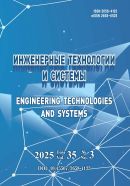DOI: 10.15507/2658-4123.035.202501.186-203
Prototype of an Electric Vehicle Based on Bigo.Land
Mikhail V. Chugunov
Cand.Sci. (Eng.), Associate Professor, Head of Chair of Design and Technology Informatics, National Research Mordovia State University (68 Bolshevistskaya St., Saransk 430005, Russian Federation), ORCID: https://orcid.org/0000-0001-5318-5684, Researcher ID: H-7452-2018, SPIN-code: 5861-0050, This email address is being protected from spambots. You need JavaScript enabled to view it.
Irina N. Polunina
Cand.Sci. (Ped.), Associate Professor of Chair of Design and Technology Informatics, National Research Mordovia State University (68 Bolshevistskaya St., Saransk 430005, Russian Federation), ORCID: https://orcid.org/0000-0002-1093-8401, SPIN-code: 3406-3859, This email address is being protected from spambots. You need JavaScript enabled to view it.
Alexander Yu. Ovchinnikov
Cand.Sci. (Eng.), Senior Lecturer at the Department of Mechanical Engineering Technology, National Research Mordovia State University (68 Bolshevistskaya St., Saransk 430005, Russian Federation), ORCID: https://orcid.org/0000-0001-6796-1824, This email address is being protected from spambots. You need JavaScript enabled to view it.
Abstract
Introduction. Modern electric vehicle industry is actively developing in many areas. Developing design and implementing a design decision for an electric vehicle are urgent tasks, including many specific interconnected research, design and technological problems. This article discusses a prototype electric vehicle, in which there is implemented a design decision based on combined control, which includes manual, remote and program control.
Aim of the Study. The study is aimed at developing and implementing a design decision for an electric vehicle prototype with a combined control system in manual, remote (by radio) and unmanned mode that allows the pilot to easily and safely change the control mode.
Materials and Methods. To solve the problem, there were used modern modeling and design methods based on an integrated approach involving the development of virtual (CAx) and full-scale models based on the Bigo.Land constructor and ArduPilot.
Results. The result of the study is an integrated model of an electric vehicle prototype in general and, in particular, a full-scale model, CAx models, a control system providing combined remote, software and manual control. The components (full-scale and virtual) of the integrated object are connected by the same control system.
Discussion and Conclusion. The developed integrated software and hardware model of an electric vehicle prototype, trajectory control system and the results of this model analysis provide the functional of a combined electric vehicle control system and can be used by designers and manufacturers of this type of machinery.
Keywords: electric vehicle, CAD/CAE, autonomous mobile machinery, full-scale and virtual models, combined control, overrunning clutch portion, prototyping
Conflict of interest: The authors declare that there is no conflict of interest.
Funding: The publication is carried out within the framework of the project “CAD development and analysis of design solutions”, implemented by the winner of the grant competition for teachers 2023/2024 of the Vladimir Potanin Scholarship Program.
Acknowledgments: The authors thank the anonymous reviewers, and also express their gratitude to the Vladimir Potanin Foundation, which supported this project.
For citation: Chugunov M.V., Polunina I.N., Ovchinnikov A.Yu. Prototype of an Electric Vehicle Based on Bigo.Land. Engineering Technologies and Systems. 2025;35(2):186–203. https://doi.org/10.15507/2658-4123.035.202502.186-203
Authors contribution:
M. V. Chugunov – formulating the idea, goals and objectives of the study; preparing the manuscript: critical analysis of the manuscript draft and comments and of the corrections made by the members of the research group during the pre-publication and post-publication stages, carrying out of the studies including CAx modeling.
I. N. Polunina – carrying out the studies including CAx modeling; preparing the manuscript including its translation into a foreign language; visualizing the study results.
A. Yu. Ovchinnikov – carrying out the studies including the carrying out of physical experiments and collecting of data; preparing the manuscript: writing a manuscript draft.
All authors have read and approved the final manuscript.
Submitted 02.12.2024;
revised 18.12.2024;
accepted 27.12.2024
REFERENCES
- Afanacyev A.N., Sazomov M.V. [Prospects for the Development of Electric Transport]. Simvol Nauki. 2020;(12-1):29–31. (In Russ.) Available at: https://os-russia.com/SBORNIKI/SN-2020-12-1.pdf
- (accessed 23.09.2024).
- Mubarakshina R.R., Valeeva Yu.S. Market Development Analysis Electric Transport in Russia. Vestnik of Volga State University of Technology. Ser.: Economics and Management. 2022;53(1):57–65. (In Russ., abstract in Eng.) https://doi.org/10.25686/2306-2800.2022.1.57
- Malyshev V.P., Russkova I.G. Electric Vehicles in the Russian Federation: Pro and Contra. Vestnik IAELPS. 2023;28(3):23–26. (In Russ., abstract in Eng.) https://www.elibrary.ru/sdidtp
- Levitskiy E.N., Zelenina A.N., Lvovich I.Ya. The Impact of the Production and Operation of Electric
- Vehicles on the Environment. Vestnik Voronezhskogo Instituta Vysokih Tekhnologij. 2023;46(3):6–7.
- (In Russ., abstract in Eng.) https://www.elibrary.ru/atnxtl
- Macharia V.M., Garg V.K., Kumar D. A Review of Electric Vehicle Technology: Architectures, Battery Technology and its Management System, Relevant Standards, Application of Artificial Intelligence, Cyber Security, and Interoperability Challenges. IET Electrical Systems in Transporttation. 2023:e12083. https://doi.org/10.1049/els2.12083
- Buechel M., Frtunikj J., Becker K., Sommer S., Buckl C., Armbruster M., et al. An Automated Electric Vehicle Prototype Showing New Trends in Automotive Architectures. 2015 IEEE 18th International Conference on Intelligent Transportation Systems. 2015:1274–1279. https://doi.org/10.1109/ITSC.2015.209
- Hubert M.A., Valdiero A.C., Goergen R., Stein E., Regner R.R., Maciel B.-H. Low-Cost Photovoltaic Maximum Power Point Tracking Project for Autonomous Electric Vehicle Prototype. Proceedings of IDEAS 2019. Smart Innovation, Systems and Technologies. 2020;198:416–424. https://doi.org/10.1007/978-3-030-55374-6_41
- Waragai M., Takayama T. Development of a High-Speed and Low-Torque Loss Two-Way Clutch. Robomech Jornal. 2022:9:21. https://doi.org/10.1186/s40648-022-00236-6
- Controzzi M., Cipriani C., Carrozza M.C. Miniaturized Non-Back-Drivable Mechanism for Robotic Applications. Mechanism and Machine Theory. 2010;45(10):1395–1406. https://doi.org/10.1016/j.mechmachtheory.2010.05.008
- Controzzi M., Luciani L.B., Montagnani F. Unified Approach to Bi-Directional Non-Back Drivable Roller Clutch Design. Mechanism and Machine Theory. 2017;116:433–450. https://doi.org/10.1016/j.mechmachtheory.2017.06.010.
- Nagler N., Lohrengel A. Improved Design Criterion for Frictionally Engaged Contacts in Overrunning Clutches. Forschung im Ingenieurwesen. 2021;85:1053–1063. https://doi.org/10.1007/s10010-021-00496-5
- Siedel T., Lukac D., Geppert T., Benckendorff C., Hild M. Operating Characteristics of a Passive, Bidirectional Overrunning Clutch for Rotary Joints of Robots. XXIII International Symposium on Information, Communication and Automation Technologies. 2011. https://doi.org/10.1109/ICAT.2011.6102087
- Imran M.N., Baharom M.B. Simplified Modelling Method to Predict Output Speed of an Overrunning Clutch Using ADAMS/Solver Subroutine. ARPN Journal of Engineering and Applied Sciences.
- ;11(22):13038–13041. Available at: http://www.arpnjournals.org/jeas/research_papers/rp_2016/jeas_1116_5343.pdf (accessed 23.09.2024).
- Zhao H., Wang B., Zhang G., Li J. Concept of a New Overrunning Clutch with the Characteristic of Reverse Force Transfer at High Speed. Engineering Reports. 2021;3(11):e12415. https://doi.org/10.1002/eng2.12415
- Chugunov M.V., Polunina I.N., Divin A.G., Generalova A.A., Nikulin A.A., Bychkov D.S. Integrated Mobile Robotic Platform Model. Engineering Technologies and Systems. 2021;31(4):609–627. (In Russ., abstract in Eng.) https://doi.org/10.15507/2658-4123.031.202104.609-627
- Chugunov M.V., Polunina I.N., Ermishov I.A. Integrated Models of Mobile Robot Transport Platform. Izvestiya Tul’skogo Gosudarstvennogo Universiteta. Tekhnicheskie Nauki. 2023;(11):528–534. (In Russ., abstract in Eng.) https://doi.org/10.24412/2071-6168-2023-11-528-529
- Chugunov M.V., Polunina I.N., Ermishov I.A. Ardupilot-Based Virtual Mobile Robot Trajectory Control Software. Izvestiya Tul’skogo Gosudarstvennogo Universiteta. Tekhnicheskie Nauki. 2022;(8):386–389. (In Russ., abstract in Eng.) https://doi.org/10.24412/2071-6168-2022-8-386-390
- Chugunov M.V., Polunina I.N., Pjanzin A.M. E-Tricycle Vehicle Design Based on Parametric CAD/CAE Models. Engineering Technologies and Systems. 2020;30(3):464–479. (In Russ., abstract in Eng.) https://doi.org/10.15507/2658-4123.030.202003.464-479
- Berestova S.A., Misyura N.E., Mityushov E.A. Kinematic Control of Vehicle Motion. Vestnik Udmurtskogo Universiteta. Matematika. Mekhanika. Kompyuternye Nauki. 2015;25(2):254–266.
- (In Russ., abstract in Eng.) https://doi.org/10.20537/vm150210
- Vasiliev A.V. Aspects of Mobile Robots Classification. Extreme Robotics. 2014;25(1):41–45. (In Russ., abstract in Eng.) https://www.elibrary.ru/wtdcyt
- Sharp R.S., Granger R. On Car Steering Torques at Parking Speeds. Proceedings of the Institution of Mechanical Engineers, Part D: Journal of Automobile Engineering. 2003;217(2). https://doi.org/10.1177/095440700321700202

This work is licensed under a Creative Commons Attribution 4.0 License.

















